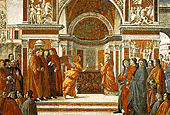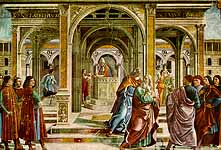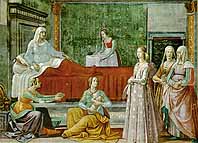
Ghirlandaio,
Angel apparition to Zacchary
A suggestive garden, which was in actual fact used in the fourteenth century as a burial ground, the so-called Cemetery of Plaona, can be seen on the righthand side of the Basilica. It once contained as many as 80 tombs placed underneath the typical Gothic sepulchre arches: in fact they gave the name to the street, Via degli Avelli (tombs), that connects Piazza Santa Maria Novella with Piazza Stazione. Painter Domenico Bigordi, better known as Ghirlandaio, was buried in one of these tombs in 1494, the third from the facade; the arch above it once contained a life-size portrait of him. Portraits of all the Bigordi family can be seen in the frescoes in the Main Chapel.

Ghirlandaio,
Joachim expelled from the temple
Several fair-haired Florentine beauties such as Giovanna degli Albizi, Ludovica Tornabuoni Nasi and Ginevra dé Benci (to whom Lorenzo the Magnificent was to dedicate two sonnets) parade past on the wall, as well as the entire Ghirlandaio family (in the fresco showing Joachim being expelled from the Temple) and some of the most important intellectuals of the time. Marsilio Ficino, Cristoforo Landino, Agnolo Poliziano and Gentile dé Becchi, Lorenzo the Magnificent's tutor (though it may be Calcondila, who was teaching Greek at the Florentine University at the time), appear in the foreground on the left in the Apparition of the Angel to Zacharias. Lucrezia Tornabuoni, sister to Giovanni, the head of the family, and, more important still, Piero dé Medici's wife and Lorenzo the Magnificent's mother, is portrayed in the scene of the Birth of the Baptist.

Ghirlandaio, Birth of S.John
Dianora, the other Tornabuoni sister and Gonfaloniere Tommaso Soderini's wife, can instead be found in the Visitation. All the protagonists in this hardly sacred and most profane film in paint were identified thanks to a document of 1561 where a rather strange old man of ninety declared he knew them all and even drew a sketch of the various figures, numbering and identifying everyone. This is a real deification of the aristocratic, worldly and somewhat fatuous atmosphere that surrounded Lorenzo the Magnificent's court and was carried out in the same period as Botticelli's painting of the Birth of Venus; only a few years after being painted the frescoes of the Basilica were to be severely criticised and condemned for their "worldliness" by Savonarola.
